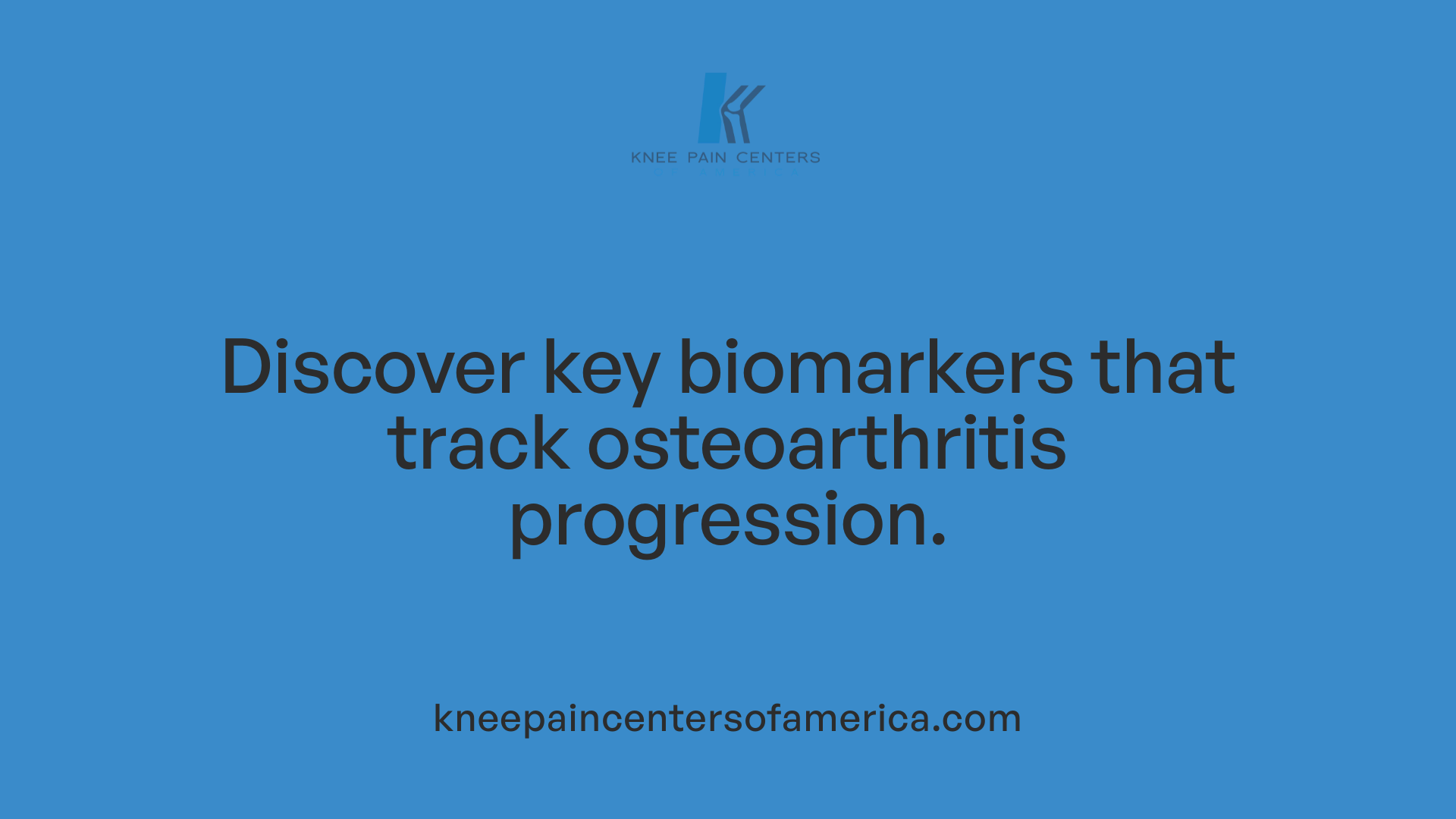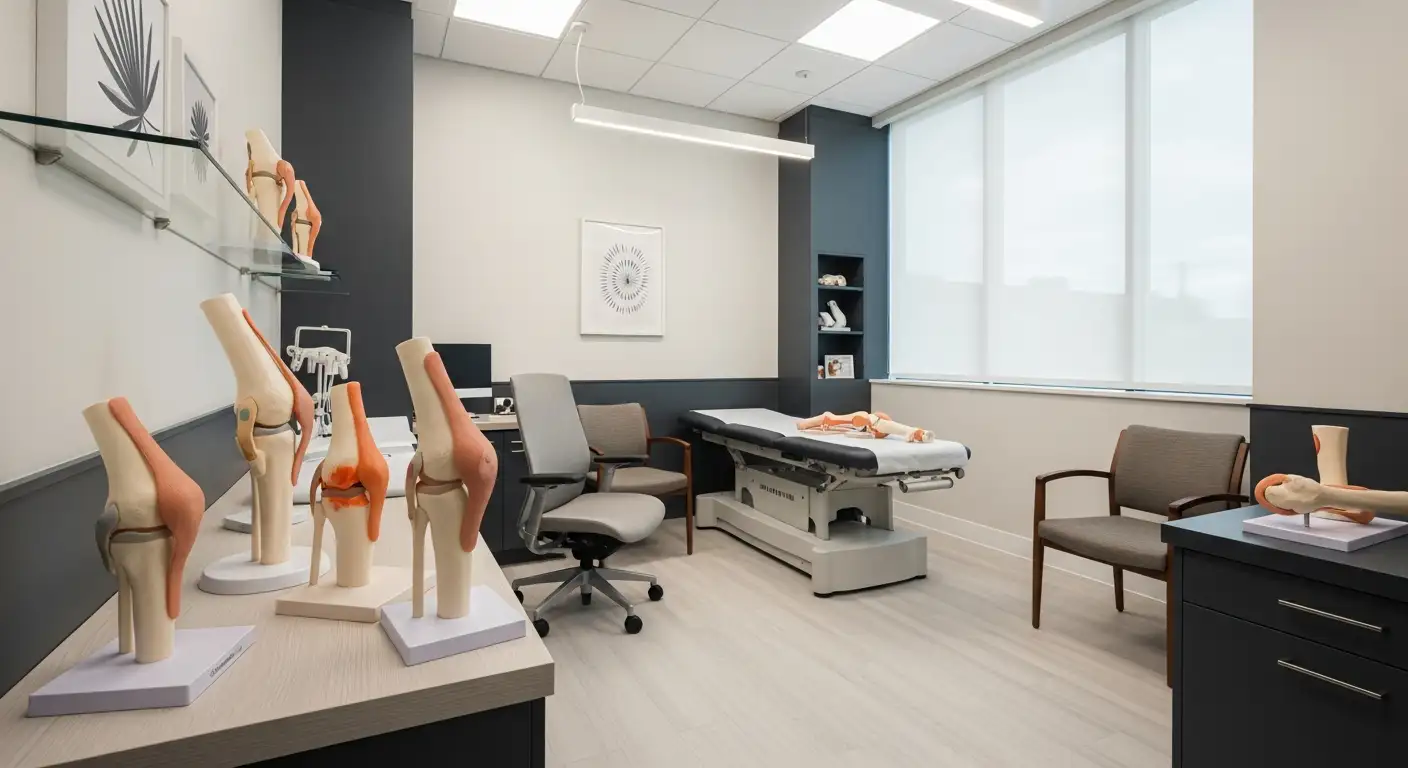Understanding How Knee Osteoarthritis Develops and Progresses
Knee osteoarthritis (OA) is the most common degenerative joint disease globally, affecting millions, particularly the elderly. Its progression involves complex biological, mechanical, and genetic factors leading to cartilage deterioration, subchondral bone changes, and inflammation. This article explores the stages of knee OA, underlying mechanisms, risk factors, diagnostic tools, biomarkers, and current management strategies, offering a comprehensive overview of disease progression.
The Fundamentals of Knee Osteoarthritis Development
What causes and risk factors contribute to the development of knee osteoarthritis?
Knee osteoarthritis (OA) is primarily caused by the gradual wearing down of the cartilage that cushions the ends of the bones in the knee joint. This deterioration results from a combination of factors, both modifiable and non-modifiable.
Age is a major non-modifiable risk factor, with the incidence increasing significantly in older populations. Women over the age of 50 are particularly vulnerable to developing OA, partly due to hormonal changes that can affect joint health.
Genetics also play a role; inherited joint abnormalities or genetic predispositions can make some individuals more susceptible. Certain genetic markers influence the structure and integrity of joint tissues, making cartilage more prone to wear.
Lifestyle choices significantly impact the development of OA. Obesity is a critical modifiable risk factor because excess weight places additional stress on weight-bearing joints like the knees. For each pound gained, the knee joint experiences nearly four pounds of extra stress, accelerating cartilage breakdown.
Previous joint injuries, especially ligament tears or fractures, increase OA risk by damaging the structural integrity of the joint and promoting abnormal load distribution.
Repetitive stress from high-impact activities, demanding occupations, or sports can contribute to cartilage deterioration. Malalignment or deformities such as knock knees or bow legs lead to uneven joint load sharing, which stresses specific areas of cartilage and hastens deterioration.
Other factors include joint deformities and certain metabolic diseases that influence joint health. Collectively, these elements create an environment conducive to cartilage wear, inflammation, and joint degeneration, ultimately leading to osteoarthritis.
Stages of Knee Osteoarthritis: An Overview of Structural Changes

What are the stages of knee osteoarthritis and their characteristics?
Knee osteoarthritis (OA) develops gradually through four main stages, each marked by specific structural changes visible on imaging and distinctive symptoms.
Stage 1 (Minor or initial stage) is often asymptomatic. On X-ray, small bone spurs (osteophytes) may start forming, and minor cartilage wear can be detected. Despite these changes, cartilage remains largely intact, and many individuals experience no pain or discomfort.
Stage 2 (Mild or early stage) presents with mild symptoms such as discomfort, stiffness, and sometimes mild swelling. Imaging studies, especially X-rays, reveal narrowing of joint space and prominent osteophyte growths. Cartilage loss remains relatively minimal, so soft tissue irritation is usually mild.
Stage 3 (Moderate stage) is characterized by increased cartilage destruction, leading to more noticeable symptoms. Patients often report frequent pain, swelling, and stiffness. X-rays show significant joint space narrowing, larger osteophytes, and more pronounced changes in the bone such as thickening. The soft tissues around the joint may show signs of irritation, and joint function begins to decline.
Stage 4 (Severe or end stage) marks the most debilitating phase. Here, cartilage erosion is nearly complete, with the bones grinding directly against each other—a condition known as bone-on-bone contact. Imaging displays marked joint space loss, large osteophytes, and joint deformity. Symptoms include intense pain, severe stiffness, and significant functional impairment, often leading to the necessity of surgical intervention such as knee replacement.
Understanding these stages helps in planning appropriate treatment strategies, aiming to slow disease progression and manage symptoms effectively.
Clinical Signs and Symptoms in Disease Progression

What are the symptoms and signs associated with each stage of knee osteoarthritis?
The symptoms and signs of knee osteoarthritis (OA) change as the disease progresses through its various stages. Recognizing these changes helps in timely diagnosis and management.
In the early stages (Stage 1), there are often no noticeable symptoms. Small cartilage wear and minor bone spur formation may occur, but these are usually asymptomatic. Imaging might reveal subtle changes, but the individual might feel perfectly fine.
As OA advances to Stage 2, mild symptoms begin to emerge. Patients typically report discomfort and stiffness after activity or prolonged rest. Tenderness around the knee and the presence of bone spurs—bony protrusions at the joint edges—are common signs. These changes can be detected through physical examination and imaging, revealing narrowing of joint space.
In the moderate stage (Stage 3), symptoms become more apparent and frequent. Patients often experience persistent pain, swelling, and a sensation of grating or cracking—known as crepitus—during joint movement. Locking of the knee can occur when loose cartilage fragments interfere with joint motion. Mobility is noticeably reduced, and daily activities become more challenging.
At the most severe stage (Stage 4), symptoms are intense and disabling. Severe pain is persistent, often present even at rest, and significant deformity of the joint may develop. There is usually almost complete cartilage loss, exposing bone-on-bone contact, which leads to intense grinding sounds and increased inflammation. The joint may become unstable, and individuals face difficulty walking, standing, or performing routine tasks.
Overall, as knee OA progresses from initial minor changes to severe joint destruction, symptoms escalate from subtle discomfort to profound pain and functional impairment. Recognizing these signs is crucial for early intervention, which can slow disease progression and improve quality of life.
The Physiological and Molecular Progression of OA
 Knee osteoarthritis (OA) advances through a series of complex physiological and molecular changes affecting multiple joint tissues. Initially, the disease starts with an imbalance where cartilage breakdown outpaces repair. This process involves the overproduction of enzymes called matrix metalloproteases (MMPs), which specifically degrade collagen and proteoglycans—key structural components of cartilage, leading to the deterioration of joint surfaces.
Knee osteoarthritis (OA) advances through a series of complex physiological and molecular changes affecting multiple joint tissues. Initially, the disease starts with an imbalance where cartilage breakdown outpaces repair. This process involves the overproduction of enzymes called matrix metalloproteases (MMPs), which specifically degrade collagen and proteoglycans—key structural components of cartilage, leading to the deterioration of joint surfaces.
In the early stages, chondrocytes, the cells responsible for maintaining cartilage, try to counteract damage by releasing tissue inhibitors of metalloproteases and producing more proteoglycans. However, these compensatory mechanisms are typically overwhelmed, resulting in decreased cartilage elasticity, increased water content, and formation of fissures.
As the disease progresses, cartilage fissures deepen, and the underlying subchondral bone becomes exposed. This exposure triggers bone remodeling processes such as sclerosis, osteophyte (bone spur) formation, and changes in bone density and shape. These alterations contribute to joint deformity and further joint surface irregularity.
A critical aspect of OA progression involves inflammation, albeit at a low level compared to inflammatory arthritis. Cytokines including interleukin-6 (IL-6), tumor necrosis factor-alpha (TNF-α), and prostaglandins play pivotal roles in perpetuating tissue degradation. These inflammatory mediators activate signaling pathways within cells, leading to increased expression of destructive enzymes and further cartilage breakdown.
Moreover, signaling pathways like NFκB, Wnt/β-catenin, and TGF-β become dysregulated, promoting chondrocyte apoptosis (cell death), abnormal cell proliferation, and matrix degradation. The involvement of these pathways underscores OA as not merely a degenerative disease but one with significant inflammatory and molecular underpinnings.
Eventually, these molecular and structural changes lead to a narrower joint space, stiffness, persistent pain, and diminished joint function. The progressive nature of these processes reflects the transition from reversible early tissue damage to irreversible joint destruction, characteristic of advanced OA.
Biomarkers and Indicators of Disease Progression

Are there biomarkers indicative of the progression of knee osteoarthritis?
Yes, identifying biomarkers that reflect disease activity and progression is a major focus of ongoing research. Several biochemical and molecular markers are associated with different aspects of osteoarthritis (OA) development and worsening.
Cartilage degradation products are among the most studied. For instance, C-telopeptide of type II collagen (CTX-II) and cartilage oligomeric matrix protein (COMP) are released during the breakdown of cartilage. Elevated levels of these markers in blood, urine, or synovial fluid can indicate ongoing cartilage destruction.
Inflammatory mediators also play a crucial role. Interleukin-6 (IL-6), tumor necrosis factor-alpha (TNF-α), and C-reactive protein (CRP) are associated with joint inflammation and synovitis, often correlating with pain and disease severity.
Markers related to bone activity provide additional insights. N-telopeptide (NTX) and bone-specific alkaline phosphatase (BSAP) reflect changes in subchondral bone remodeling, which accompanies cartilage loss.
Recent developments in biomarker research involve advanced techniques like proteomics and metabolomics. Efforts target analyzing blood, synovial fluid, and urine to uncover panels of markers that can predict how quickly OA will progress or how well it might respond to treatment.
Although promising, these biomarker panels are still largely in the research phase. They require further validation before becoming routine tools for clinicians in diagnosing or predicting progression.
| Biomarker Type | Example Markers | Relevance | Sample Medium |
|---|---|---|---|
| Cartilage Breakdown | CTX-II, COMP | Indicate cartilage degradation | Blood, urine, synovial fluid |
| Inflammatory Mediators | IL-6, TNF-α, CRP | Reflect joint inflammation and synovitis | Blood, synovial fluid |
| Bone Remodeling | NTX, BSAP | Show subchondral bone changes | Blood, urine |
| Emerging Biofluid Markers | Proteomic and metabolomic signatures | Aiming for early prediction and personalized treatment | Blood, urine, synovial fluid |
As research progresses, these markers could become essential for early detection, monitoring disease activity, and evaluating response to therapies, potentially transforming OA management.
Management Strategies: From Lifestyle to Surgery

What management and treatment options are available for different stages of knee osteoarthritis?
Managing knee osteoarthritis involves a range of strategies tailored to the severity and progression of the disease. Early stages often respond well to conservative approaches aimed at reducing symptoms and slowing disease advancement.
In the initial phases, lifestyle modifications such as weight loss can significantly decrease stress on the knee joints, especially in overweight individuals. Maintaining a healthy weight reduces the load on the knee cartilage—every extra pound applied adds nearly four pounds of additional stress. Additionally, low-impact exercises like swimming, walking on soft surfaces, and resistance training help strengthen supporting muscles and improve joint stability without aggravating symptoms.
Physical therapy plays a vital role in improving joint function and flexibility. Techniques focused on muscle strengthening and range-of-motion exercises help decrease pain and improve mobility. Over-the-counter medications like NSAIDs and acetaminophen are commonly used to manage pain; they help reduce inflammation and discomfort but do not alter disease progression.
For persistent or severe symptoms, intra-articular injections are a popular option. Corticosteroid injections can provide temporary relief by decreasing inflammation directly within the joint. Hyaluronic acid injections aim to lubricate the joint, improving movement and comfort, especially in cases where cartilage damage causes joint stiffness.
Nutraceuticals such as glucosamine and curcumin are sometimes used as complementary therapies, although scientific evidence regarding their effectiveness remains mixed. Alternative therapies like acupuncture may also be employed to manage pain and improve quality of life.
As osteoarthritis advances and conservative measures fail to provide sufficient relief, surgical options become necessary. Osteotomy procedures realign the bones to unload stress from damaged cartilage, potentially delaying the need for joint replacement. Arthroscopy allows for joint cleaning, removal of loose cartilage fragments, and smoothing of rough surfaces.
In the most severe cases, when joint degeneration is extensive, total knee replacement (arthroplasty) is considered. This procedure involves removing damaged joint surfaces and replacing them with artificial implants to restore function and alleviate pain.
The overarching goal across all treatment stages is to alleviate symptoms, improve joint function, and slow disease progression. Early intervention with conservative treatments can delay or prevent the need for surgical procedures, emphasizing the importance of timely diagnosis and management.
Factors Influencing Disease Progression and Severity
What factors influence the severity and progression of knee osteoarthritis?
The course and intensity of knee osteoarthritis (OA) are affected by several interconnected factors. Mechanical stressors such as joint malalignment, overuse, and excess weight significantly impact disease severity. When a joint bears abnormal loads or experiences uneven force distribution, cartilage wears out faster, leading to further degeneration.
Structural alterations like cartilage loss, bone spurs (osteophytes), narrowing of the joint space, and sclerosis of the subchondral bone directly correlate with disease severity. These physical changes can be seen on imaging studies and are essential markers of disease progression.
Biological mediators, especially inflammatory cytokines such as Interleukin-6 (IL-6) and Tumor Necrosis Factor-alpha (TNF-α), play a crucial role. They promote inflammation within the joint, accelerating tissue destruction and worsening symptoms.
Lifestyle choices are also influential. Maintaining a healthy weight reduces stress on weight-bearing joints like the knees, slowing disease progression. Regular, low-impact exercise helps strengthen supporting muscles, improve joint stability, and may influence inflammatory pathways favorably. Conversely, joint overuse or injury from repetitive activities can hasten damage.
Age is a non-modifiable but important factor. As individuals grow older, their tissues’ capacity to repair cartilage diminishes, making OA more severe and difficult to manage.
Genetics further contribute to variability in disease progression. Certain gene mutations that affect cartilage maintenance and repair increase the likelihood of early onset and rapid progression.
In summary, OA severity and progression depend on a combination of joint biomechanics, biological inflammation, lifestyle, aging, and genetics. Understanding these factors can help tailor more effective management strategies to slow the disease’s course.
Insights from Scientific Research and Future Directions
What advancements are being made in understanding the mechanisms of knee osteoarthritis?
Recent scientific research has significantly advanced our knowledge of knee osteoarthritis (OA) by delving into the cellular and molecular mechanisms involved in disease progression. One area of focus is epigenetics, which examines how changes in gene expression—without altering the DNA sequence—affect cartilage health. DNA methylation, histone modifications, and microRNA regulation influence the activity of genes responsible for cartilage maintenance and degradation. For example, enzymes like DNA methyltransferases (DNMTs) modify gene expression of critical cartilage factors such as Sox9 and matrix metalloproteinases (MMPs), impacting tissue integrity.
Beyond genetics, inflammation plays a central role in OA development. Signaling pathways involving cytokines like TNF-α, IL-6, and molecules such as NFκB and STAT3 are active in damaged joints, promoting chondrocyte apoptosis and cartilage breakdown. Inflammatory mediators are now recognized as critical contributors to disease progression, contrary to earlier beliefs that OA is purely degenerative.
Advanced imaging techniques, especially Magnetic Resonance Imaging (MRI), allow detailed visualization of joint tissues. MRI can detect cartilage defects, bone marrow lesions (BMLs), synovitis, and other soft tissue changes earlier than radiographs. These biomarkers are sensitive indicators of disease activity and progression, providing valuable tools for monitoring and evaluating treatment responses.
Research into biomarkers has identified proteins like ADAMTS enzymes, CHI3L1, CRTAC1, and HTRA1, which are linked to cartilage destruction and inflammation. MicroRNAs are also crucial regulatory molecules influencing inflammatory responses and chondrocyte viability.
Emerging therapies aim at these molecular pathways. Cytokine inhibitors, growth factor modulators, and gene-editing techniques like CRISPR/Cas9 hold promise for future treatment strategies. Scientists are also exploring the role of joint tissues such as the synovial membrane and the periarticular structures. Notably, the synovial lymphatic system (SLS) is gaining attention for its potential role in clearing cartilage-derived debris and inflammatory mediators, which could help in managing OA.
Overall, integrating molecular biology, advanced imaging, and biomarker research paves the way for more precise diagnosis and targeted therapies, offering hope for slowing or halting the progression of knee osteoarthritis in the future.
Looking Ahead: Improving Outcomes in Knee Osteoarthritis
Understanding the progression of knee osteoarthritis from molecular mechanisms to clinical manifestations is crucial for developing effective diagnosis, management, and eventual prevention strategies. Early detection through imaging and biomarkers can facilitate timely intervention, potentially slowing disease progression and preserving joint function. While current treatments primarily focus on symptom management, ongoing research into disease-modifying therapies offers hope for more targeted and effective options in the future. Emphasizing lifestyle modification, especially weight control and low-impact exercise, remains central in mitigating disease severity. Advances in scientific understanding and technological innovations are poised to transform how clinicians diagnose and treat knee OA, ultimately aiming for improved quality of life and reduced disability for those affected.
References
- Knee Osteoarthritis: Symptoms, Stages, Causes & Treatment
- Knee Osteoarthritis - StatPearls - NCBI Bookshelf
- Understanding the Stages of Knee Osteoarthritis
- Stages of Knee Osteoarthritis - WebMD
- Osteoarthritis Progression: Mitigation and Rehabilitation Strategies
- Knee Arthritis | Knee Osteoarthritis | Illinois Bone & Joint Institute
- Slowing Osteoarthritis Progression - Arthritis Foundation
- Arthritis in Knee: Signs, Symptoms, Causes & Treatment
- Current understanding of osteoarthritis pathogenesis and relevant ...
- Osteoarthritis - Symptoms & causes - Mayo Clinic





